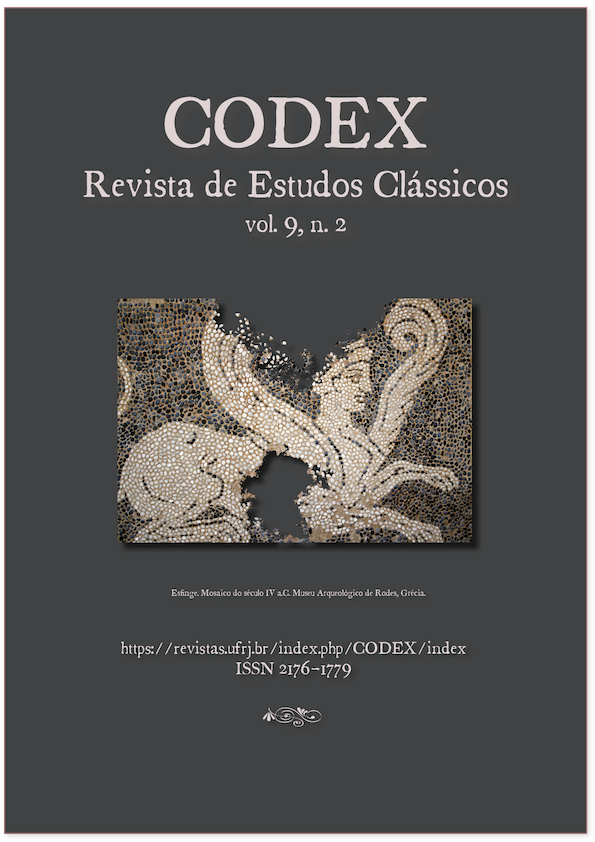“Convolvens stamina fuso”: the contexture of the threads of life in Seneca’s "Apocolocyntosis"
DOI:
https://doi.org/10.25187/codex.v9i2.43597Keywords:
Seneca, Apocolocyntosis, Menippean satire, mimetic simulationAbstract
Seneca is generally remembered for his philosophical and tragic works. However, along with those texts characterized by a stoic rigidity, the Latin writer composed a Menippean satire that has become known as Apocolocyntosis, whose argument is the failed apotheosis of the recently deceased emperor Claudius. Throughout this article, we intend to go over the origins and the meaning of the work’s title, the imitation of the satiric poet Lucilius in it, the aspects that define this text as a Menippean satire, and the use of citations by Seneca, all of which are elements that seem to make up the portrait of the mobile caput (“unstable head”) (VII, 2) that was the emperor Claudius. We study, at last, the hexametrical poem declared by Apollo, in which we have possibly found a metaphor for the contexture of Nero’s threads of life as successor to Claudius. This metaphor is set up by means of terms repeated in strategic positions in such a way that they mimetically simulate the contexture of the threads of life made by the Parcae.
References
ADAMS, G. W. The Roman Emperor Gaius “Caligula” and His Hellenistic Aspirations. Irvine: Universal Publishers, 2007.
CARDOSO, Z. de A. Introdução. In: SÊNECA. Tragédias. A loucura de Hércules; As troianas; As fenícias. Trad. Zélia de Almeida Cardoso. São Paulo: Martins Fontes, 2014, p. VII-XIX.
CONNORS, C. M. Petronius the poet. Cambridge: Cambridge University Press, 1998.
EDEN, P. T. (Org.). Seneca: Apocolocyntosis. Cambridge: Cambridge University Press, 1984.
FREUDENBURG, K. Introduction: Roman satire. In: FREUDENBURG, K. (Org.). The Cambridge companion to Roman satire. Cambridge: Cambridge University Press, 2005, p. 1-30.
FREUDENBURG, K. Seneca’s Apocolocyntosis: censors in the afterworld. In: BARTSCH, S.; SCHIESARO, A. (Org.). The Cambridge companion to Seneca. Nova York: Cambridge University Press, 2015, p. 93-105.
HELLER, J. L. The meaning of κολοκύντη. Illinois Classical Studies, Illinois, v. 10, n. 1, 1985, p. 67-117.
KORZENIEWSKI, D. Senecas Kunst der dramatischen Komposition in seiner Apocolocyntosis. Mnemosyne, v. 35, 1982, p. 103-114.
LEONI, G. D. Introdução. In: SÊNECA. Medéia. Obras de Sêneca. Trad. Giulio Davide Leoni. Rio de Janeiro: Ediouro, [19--].
MANS, M. J. The macabre in Seneca’s tragedies. Acta Classica, v. 27, 1984, p. 101-119.
O’GORMAN, E. Citation and authority in Seneca’s Apocolocyntosis. In: FREUDENBURG, K. (Org.). The Cambridge companion to Roman satire. Cambridge: Cambridge University Press, 2005, p. 95-108.
OXFORD Latin Dictionary. Oxford: Oxford University Press, 1968.
ORAZIO. Tutte le opere. Ed. Marco Beck. Milão: Mondadori, 2007.
REGO, E. de S. Sêneca e a Apocolocintose. In: REGO, E. de S. O Calundu e a Panacéia. Rio de Janeiro: Forense Universitária, 1989, p. 37-42.
RONCALI, R. Introduzione. In: SENECA. L’apoteosi negata [Apokolokyntosis]. Veneza: Marsilio, 1990, p. 16 e ss.
SENECA. La Clemenza – Apocolocyntosis – Epigrammi – Frammenti. A cura di Luciano De Biasi, Anna Maria Ferrero, Ermanno Malaspina e Dionigi Vottero. Turim: UTET, 2009.
TOVAR, R. C. Teoría de la sátira. Cáceres: Universidad de Extremadura, 1986.
Downloads
Published
How to Cite
Issue
Section
License
This work is licensed under a Creative Commons Attribution-NonCommercial 4.0 International License.










